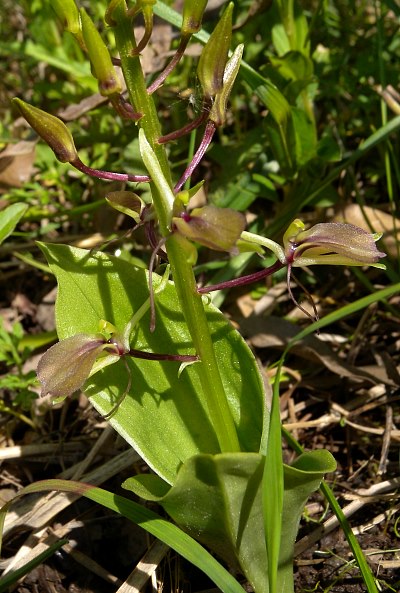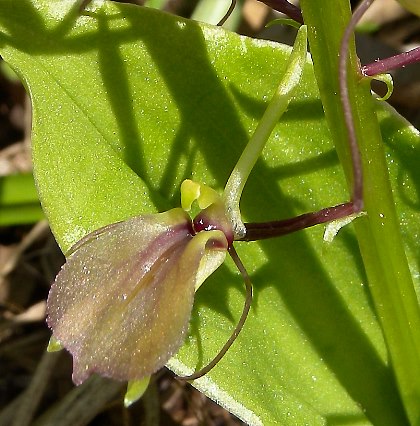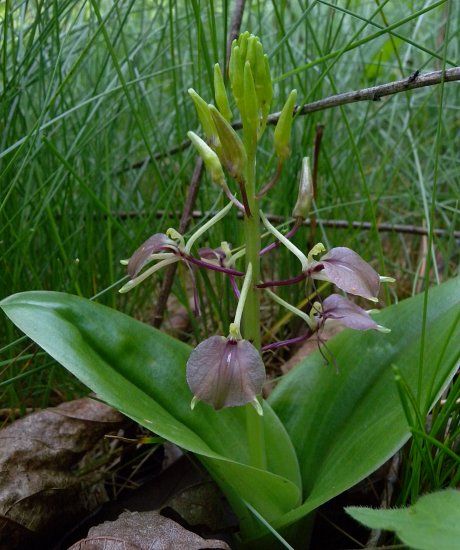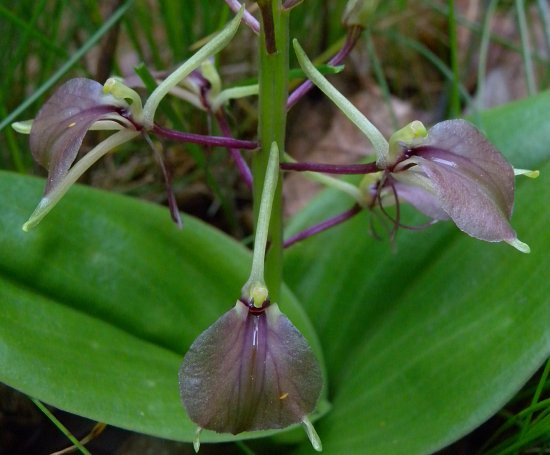Description: This perennial wildflower consists of a pair of basal leaves and a flowering stalk. The basal leaves are 3-6" long and about one-half as much across; they are medium green, glabrous, oval-ovate in shape, slightly succulent, and smooth along their margins. The lower side of each basal leaf is slightly keeled. The inflorescence is an erect raceme about 4-10" tall that bears 5-30 flowers. The central stem of the raceme is light green, hairless, and rather stout. Individual flowers are about ¾–1" across, consisting of 3 sepals, 3 petals, and a short reproductive column. Each sepal is up to ½" long, greenish white, and linear in shape. The 2 lateral petals are up to ½" long, pale purple, filiform (worm-like) in shape, and drooping. The lower petal is the lip of the flower; it is about ½" long, pale purple, obovate in shape with faint purple veins, and either flat or gently curved. Above the base of the lip, there is an incurved reproductive column less than ¼" in length that is greenish.

Each flower has a slender pedicel about ¾" long that is reddish purple and glabrous. At the base of each pedicel, there is a small triangular bract. The blooming period occurs from late spring to mid-summer and lasts 3-4 weeks for a colony of plants. The flowers begin to bloom from the bottom of the raceme to its apex. There is no noticeable floral scent. Successfully fertilized flowers produce seed capsules about ½" long or a little longer. Individual capsules are erect on their pedicels; they are ellipsoid with several longitudinal veins. Eventually, they split open to release numerous tiny seeds, which are distributed by the wind. The root system consists of a bulbous corm and slightly fleshy fibrous roots. A new corm develops adjacently to the old corm, from which future flowers and leaves will be produced; the old corm eventually withers away.

Cultivation:
Purple
Twayblade prefers partial sunlight to light shade and moist to
dry-mesic conditions in well-drained areas. This orchid adapts to many
soil types, including rich loam, sandy loam, glacial till, and thin
rocky soil with a slightly acid pH. To flourish, this orchid and its
seeds require the presence of a particular strain of a
Rhizoctonia/Tulasnella fungus. Otherwise, it cannot survive.
Range & Habitat:
The native Purple Twayblade is widely distributed throughout Illinois
(see Distribution
Map). Depending
on the area, its abundance varies from
rare to occasional. Habitats include open upland woodlands, small
openings in wooded areas from fallen trees, upland savannas and sandy
savannas, sandstone glades and partially shaded cliffs, sparse thickets
in barren areas, abandoned shrubby fields, pine plantations (if not too
shady), and small meadows in wooded areas. Purple Twayblade is
associated with oak-hickory woodlands and mixed woodlands (pines and
deciduous trees) in mesic to upland areas. Because excessive shade from
canopy trees and shrubs can cause entire colonies of plants to die out,
occasional reduction of woody vegetation from wildfires, wind-thrown
trees, etc., helps to maintain existing populations of this orchid.

Faunal Associations: Very little is known about floral-faunal relationships. If the flowers are not cross-pollinated by insect visitors, they fail to develop seed capsules. Unfortunately, such insect visitors are uncommon and largely unknown at the present time. Charles Robertson observed the Anthomyiid fly Pegoplata juvenalis and the plant bug Lopidea medius (aka Lopidea media) visiting the flowers, but he did not regard them as effective pollinators. Christensen (1994) has suggested that the floral pollinators are flesh flies (Sarcophagidae) because the pale purple color and veins of the flowers may resemble carrion. It is possible that the flowers produce an odor that the relatively insensitive human nose cannot detect. The succulent basal leaves are browsed by both White-Tailed Deer and the Cottontail Rabbit. Where these animals are abundant, populations of this orchid may experience a significant decline from excessive herbivory.

Photographic
Location:
A small meadow in Vermilion County, Illinois, and a
savanna in Champaign County, Illinois.
Comments:
The flowers of this small orchid have an unusual spidery appearance.
Lacking bright distinctive colors, they have a tendency to blend into
the background. Because no other orchid in Illinois closely resembles
Purple Twayblade, it is easy to identify. Its nearest relative in the
state, Liparis loeselii (Lesser Twayblade), has
less showy flowers that are smaller in size, yellow-green, and
self-fertile. Instead of Purple Twayblade, other common names of Liparis
liliifolia are Large Twayblade and Lily-Leaved Twayblade.